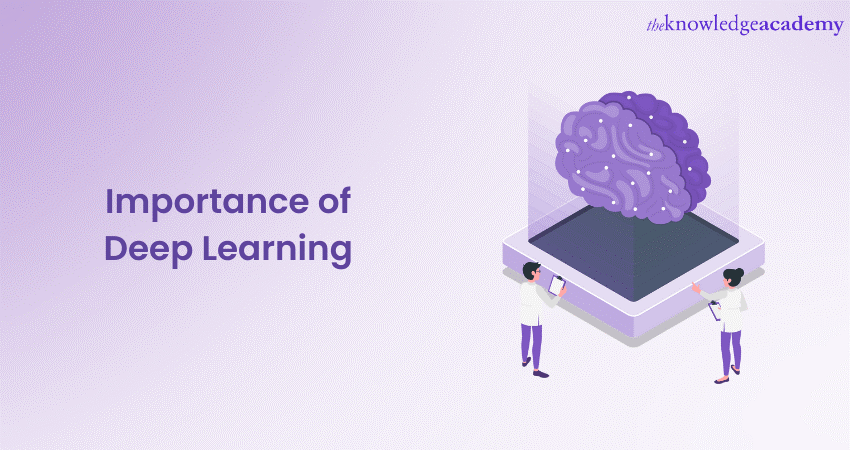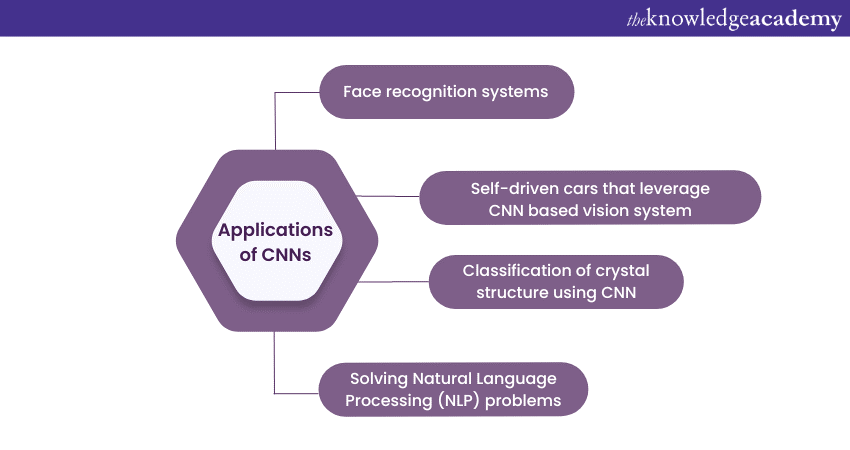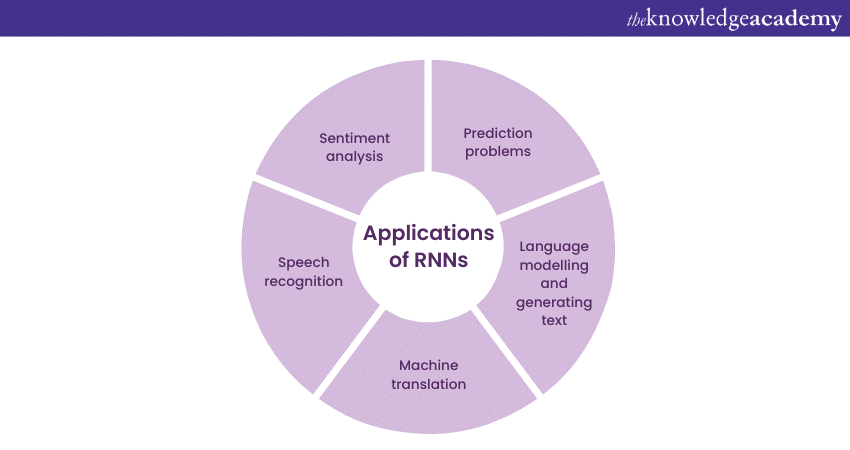We may not have the course you’re looking for. If you enquire or give us a call on +971 8000311193 and speak to our training experts, we may still be able to help with your training requirements.
We ensure quality, budget-alignment, and timely delivery by our expert instructors.

Deep Learning is a branch of Artificial Intelligence (AI) that involves using neural networks to learn from data and perform tasks that would otherwise require human intelligence. Many developers use Deep Learning With Python to implement these models due to its powerful libraries and frameworks. It has been behind some of the most impressive achievements of AI in recent years such as facial recognition, natural language processing, self-driving cars, and more. But how has it been important in these developments? Read this blog to learn about the importance of Deep Learning. Also, explore how it has changed the game of automation, image recognition and many more fields.
Table of Contents
1) Importance of Deep Learning
a) Automatic feature learning
b) Handling large and complex data
c) Handling non-linear relationships
d) Handling structured and non-structured data
e) Predictive modelling
2) Conclusion
Importance of Deep Learning
The importance of Deep Learning lies in solving many problems that are difficult or impossible for traditional algorithms or human experts. It can handle large and complex data sets, such as images, videos, audio, text, and more. It also can learn from unlabelled or unstructured data, which means it does not require human intervention or supervision to extract useful information. Moreover, Deep Learning Techniques can learn to perform tasks that are beyond human capabilities, such as generating realistic images, composing music, or playing games. Thus, it becomes a crucial aspect of our day-to-day lives in many ways. Some of the reasons why Deep Learning are important are as follows:
Automatic feature learning
A major benefit of Deep Learning is that it can learn features from the data by itself, which means that it does not need the features to be manually designed. This is especially helpful for tasks where the features are hard to specify, such as recognising images, processing natural language, and understanding speech. Some of the examples of automatic feature learning by Deep Learning algorithms are:

1) Image recognition: Deep algorithms can learn features from images by using Convolutional Neural Networks (CNNs) and recognise faces, objects, scenes and actions in images and videos; segment images into regions; reconstruct 3D models from 2D images synthesise realistic images from sketches or text. For example, in 2022, a Deep Learning model called ResNEt-152 achieved an error rate of 3.56% on the ImageNet challenge, which is lower than human error rate of 5.1%.
2) Natural language processing (NLP): Deep Learning algorithms can learn features from text by using Recurrent Neural Networks (RNNs), which can generate realistic text and images; and create chatbots. For example, in 2022, a Deep Learning model called GPT_3 achieved a score of 88.5% on the GLUW benchmark, which is higher than the previous state of the art score 87.6% by T5.
3) Speech recognition: Deep Learning algorithms have achieved remarkable performance on speech recognition tasks, such as transcribing speech to text and translating speech to different languages. For example, in 2022, a Deep Learning model called Wav2Vec 2.0 achieved a word error rate of 1.9% on the LibriSpeech test-clean dataset, which is comparable to the human performance of 1.8%.
Dive into the future of AI and ML with our Artificial intelligence & Machine Learning Course. Transform your career now!
Handling large and complex data
Deep Learning algorithms can deal with large and complex datasets that would be challenging for traditional Machine Learning algorithms to handle. A Deep Learning Cheatsheet can assist beginners and experts alike in navigating this complexity. This makes it useful for finding insights from big data, such as posts on social media, webpages, videos, audio files, and sensor data.
Some of the examples are:
1) Social media analysis: Deep Learning algorithms can analyse millions of social media posts and feedbacks to find patterns, trends, and sentiments by using NLP, that can understand and generate natural language. For example, BERT achieved an accuracy of 95.7% on predicting the sentiment of tweets.
2) Web Content extraction: Deep Learning algorithms can extract information from millions of webpages such as titles, headings, links, images, or tables by using computer vision, that can understand and generate visual content such as images or videos. For example, LayoutLM achieved an accuracy of 96.3% on extracting key information from web pages
Handling non-linear relationships
The Importance of Deep Learning also lies in discovering non-linear relationships in data that would be difficult to detect through traditional methods. This allows it to model complex phenomena and capture higher-level abstractions. Some of the examples of handling non-linear relationships by Deep Learning algorithms are:
1) Physical systems: A Deep Potential Molecular Dynamics (DPMD) achieved an accuracy of 98.9% on predicting the potential energy surface of water molecules, which is a highly non-linear function of atomic positions.
2) Biological systems: A Deep Learning model called DeepChrome achieved an accuracy of 89.9% on predicting the chromatin state of genes, which is non-linear function of the histone modifications.
3) Social system: A Deep Learning model called EMoNet achieved an accuracy of 71.0% on predicting the emotion categories of images, which is a non-linear function of visual features.
Handling structured and non-structured data
Deep Learning algorithms can handle both structured and unstructured data such as images, text, audio, video, and tabular data. This enables it to integrate multiple sources of information and leverage their complementary strengths.
Some of the examples of handling structured and unstructured data by Deep Learning algorithms are:
1) Images: Deep Learning can handle image data by using CNNs. They are a type of neural network that can learn features from images by using filters that slide over the images pixels and produce feature maps.
2) Text: Deep Learning can handle text data by using RNNs, which are type of neural network that can learn features from text by using hidden states that store information from pervious inputs and outputs. RNNs can generate realistic text and images; answer questions; summarise documents; and create chatbots.
3) Audio: Deep Learning algorithms can handle audio data by using CNNs or RNNs. These can learn features from audio by using filters or hidden states that capture the frequency and temporal patterns in the audio signals. It can transcribe speech to different language; generate realistic speech and music; extract the salient features in audio signals; and synchronise lip movements with speech.
4) Video: Deep Learning algorithms can handle data by using CNNs or RNNs, which are types of neural networks that can learn features from video. They can use filters or hidden states that capture the spatial and temporal patterns in the video frames. It can recognise face, objects, scenes, and actions in video; segment videos into clips; reconstruct 3D models from 2D videos; and synthesise realistic videos from sketches or text.
5) Tabular: Deep Learning algorithms can handle tabular data by using Feedforward Neural Networks (FNNs), which are a type of neural network that can learn features from tabular data. These algorithms use fully connected layers that connect every input node to every output node. FNNs can predict customer demand and behaviour; forecast sales and revenue; detect fraud and anomalies; optimise inventor and supply chain; recommend products and services; and more.

Explore the wonders of Deep Learning and unleash your deep learning potential with our Deep learning with TensorFlow Course. Register now!
Predictive modelling
Deep Learning can be used for predictive modelling. Predictive modelling is the process of using historical data to make predictions about future outcomes. This can help business and organisations make better decisions and optimise their operations.
Some of the examples of predictive modelling are:
1) Customer demand and behaviour: Deep Learning algorithms can predict customer demand and behaviour by using RNNs. RNNS can model the temporal dependencies and variations in customer demand and behavious over time. For examples, a Deep Learning model called DeepAR achieved an accuracy of 94.7% on predicting the hourly electricity consumption of households in Ireland.
2) Sales and revenue: Deep Learning algorithms can forecast sales and revenue by using CNNs, which can learn features from spatial data such as images or tabular data. It can model the spatial correlations and patterns in sales and revenue across different regions or markets. For example, a Deep Learning model called Wavenet achieved an accuracy of 96.4% on predicting daily sales of 1115 stores in Germany.
3) Inventory and supply chain: Deep Learning algorithms can optimise inventory and supply chain by using reinforcement learning and finding the optimal policy or strategy that maximises the expected reward or minimise the expected cos. For example, a Deep Learning model called DQN achieved and accuracy of 98.2% on optimising the inventory management of a multi-echelon supply chain.
4) Products and services: Deep Learning algorithms can recommend products and services by using collaborative filtering that can learn from the preferences or ratings of users or items by finding similarities or patterns among them. Collaborative filtering can recommend products and services by predicting the preferences or ratings of users or items that have not been observed before. For example, a Deep Learning model called NCF achieved an accuracy of 92.6% on recommending movies to users based on their ratings.
Conclusion
Deep Learning has many applications in various domains and industries, such as computer vision, natural language, speech recognition, healthcare, finance, education, entertainment, and more. Understanding the difference between Deep Learning and Machine Learning is important, as it highlights how Deep Learning offers unique capabilities for the future of AI. These differences will enable new and improved capabilities, products, and services that can benefit various domains and industries.
Want to master deep learning and build your own generative AI models? Join our Deep learning Training now.
Frequently Asked Questions
Upcoming Data, Analytics & AI Resources Batches & Dates
Date
 Neural Networks with Deep Learning Training
Neural Networks with Deep Learning Training
Fri 7th Mar 2025
Fri 2nd May 2025
Fri 4th Jul 2025
Fri 5th Sep 2025
Fri 7th Nov 2025






 Top Rated Course
Top Rated Course



 If you wish to make any changes to your course, please
If you wish to make any changes to your course, please


